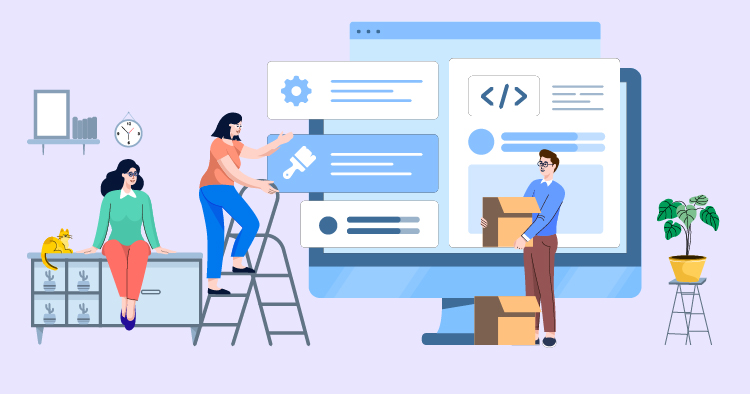If you run a small business, having a solid online presence is no longer optional—it’s essential. A well-designed website can set your business apart, capturing the attention of potential customers. But what makes a website truly effective goes beyond good looks. It’s about creating an online space that’s easy to navigate and connects with visitors on a deeper level. This means thinking about everything from how quickly your pages load to your site’s appearance on a smartphone. As technology and user habits change, so do the elements of a top-notch web design. This article will delve into the must-have web design features that small business owners should prioritize to make their websites stand out and perform well.
What is web design?
Web design is about creating websites. It mixes good looks with an easy-to-use design. It includes ensuring the graphics are excellent, the user experience is good, the layout makes sense, the website appears well in search engines, and the information is correct. The primary goal is to create an online place where people can get what they need and have a good time doing it so they’ll return.
For small businesses, having an excellent website is extremely important. It’s more than just a place to sell your product or services; it’s a big part of how you tell people who you are and what you do. An easy-to-use design can help you inform your customers, which can help your business grow.
Building a Solid Foundation: Planning Your Website
Knowing who you’re talking to with your website is extremely important. When creating your website, consider your audience and make everything from the design to the words with them in mind. When your site feels right for the people you want to visit, they’re more likely to use it, buy things, and come back.
You need to know what you want your website to do. Do you want to generate leads, share information, sell products, or connect people? Your goals should shape how your website looks and what’s on it. Your business will benefit when you concentrate your site on your goals.
The key to making your website work well is its setup and ease of navigation. When people find what they need without trouble, they’re happier and more likely to stay. Good titles, an intelligent layout, and a simple menu are essential to keep people interested and prevent them from leaving too soon.
Creating an Eye-Catching Design
The look of your website is critical to making a great first impression. Your chosen colors and fonts should reflect your brand’s personality and connect with your audience. Since colors and font styles can affect how people see your brand, picking them carefully is essential. Think about what emotions you want to evoke and choose your design elements accordingly.
Images and graphics can do a lot to tell a website’s story. They make your message more transparent, add visual appeal, and help break up text. They also direct visitors to essential parts of your site. Remember, the right images and graphics are vital for a user experience that sticks in people’s minds.
Select one of over 500 designs and establish your online presence.
- Free Web Hosting
- Fully Managed Solutions
- Scalable Websites
- No Hidden Cost
Responsive Web Design for Enhanced User Experience
As more people use their phones and tablets online, your website must work well on these devices. Responsive design means your site looks good and is easy to use, no matter the device’s screen size. This is important for user satisfaction because search engines like Google prefer mobile-friendly sites.
When making a website responsive, you use flexible grids, scalable images, and media queries to ensure it looks great on any device. You might need to tweak your menus to simplify, ensure images load quickly, and ensure that buttons and links are easy to use on a touchscreen. A responsive site provides a better experience and helps your site perform better.
Optimizing Website Speed and Performance
Your website’s page load time is crucial to keep visitors happy and for search engine optimization (SEO). If a site is slow, people will likely leave before seeing your offer. A quick website, however, can keep people interested and more willing to stick around and take action.
To speed up your site, you can shrink image sizes, use networks that help deliver content faster, and streamline coding for your stylesheets and scripts. It’s also essential to make sure your server responds quickly. Monitoring your site’s speed and performance regularly will help you spot and solve any issues quickly, ensuring visitors have the best experience possible.
Creating Compelling Website Copy
Your website’s content should grab attention and provide valuable information to your audience. It’s about more than just selling something; it’s about sharing knowledge and stories that matter to your visitors. By providing exciting and valuable content, you can build trust with your audience and establish yourself as a leader in your industry.
Search engine optimization (SEO) is vital for getting your website noticed. You can help your site increase search engine rankings by integrating the right keywords. But remember, the key is to use these words throughout your content in a natural way that keeps your writing enjoyable to read.
User-Friendly Forms and Calls to Action
Forms are vital to your website when you need to gather information from visitors. They need to be straightforward and hassle-free to fill out. Make forms user-friendly, keep them simple, label each field clearly, and give easy-to-follow instructions. This approach can lead to more people completing your forms and, ultimately, more leads or transactions.
Calls to action (CTAs) are the signposts that tell users what to do next, like signing up for a newsletter or buying a product. Good CTAs are easy to spot, persuasive, and placed where users can’t miss them, but they shouldn’t be too pushy or distracting.
Integrating Social Media and Sharing Features
Linking your website with your social media profiles can improve your online presence. It can help you engage more with your audience and create a community around your brand. This connection makes it easier for visitors to find you on social media and stay in touch.
Select one of over 500 designs and establish your online presence.
- Free Web Hosting
- Fully Managed Solutions
- Scalable Websites
- No Hidden Cost
Adding social sharing buttons to your site makes it easy for visitors to spread the word about your content. These buttons should be noticeable, but not in a way, placed where people can find them quickly so they can share your content with just a click. This can lead to more eyes on your website and a wider audience for your message.
Ensuring Website Security and Trustworthiness
Website security is not something to take lightly. Protecting sensitive data, like customer information and payment details, is essential. When your website is secure, customers feel safe interacting with it, and this trust can be good for your business’s reputation. If you don’t focus on security, you could face data breaches, which might cause customer loss and damage to your brand.
To keep your website safe, regularly update your software and systems. Choose a hosting provider that prioritizes security. Ensure your site has an SSL certificate, which encrypts data and shows visitors your site is secure. Use strong passwords and change them regularly. Conducting regular security checks to find and fix vulnerabilities is also wise. Keeping up with the latest security trends and solutions is equally important to protect your site against new threats.
Tracking and Analyzing Website Performance
Analytics are like a window into how people use your website. They show you where your visitors come from, what they do on your site, and how engaged they are. This information is critical to figuring out what’s working and what’s not. By understanding your website’s performance, you can make informed changes that could lead to more visitors, better engagement, and higher sales.
Many tools are available to help you understand your website’s performance. Google Analytics is a popular choice to track visitors’ interaction with your site. It can show how many people visit your site, how they found it, and what they do there. This information is invaluable for making intelligent decisions about improving your website.
Final Thoughts
Excellent web design is about more than looks—it’s about creating an effective online tool. For small businesses, this means a website that catches the eye, works well, meets user needs, and supports business goals. A well-designed website can help your business stand out online, provide a great user experience, and pave the way for success in the digital world. By following these guidelines, small businesses can develop beautiful and powerful websites, ensuring they are well-equipped to thrive online.



